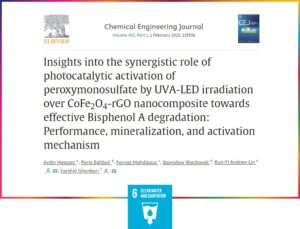
A study conducted by researcher Hassani at Near East University, in collaboration with other institutions, introduces a novel approach to effectively tackle emerging pollutants in wastewater. The study focuses on the degradation of Bisphenol A (BPA), a significant emerging pollutant, utilizing a nanocomposite called CoFe2O4-reduced graphene oxide (CFO-rGO) under UVA-LED irradiation.
The research team successfully synthesized CFO-rGO and extensively characterized it using advanced techniques such as XRD, FTIR, FESEM, EDX-mapping, TEM, XPS, BET-BJH, Raman spectrometry, VSM, PL, and EIS analyses. Through systematic experimentation, they elucidated the operating factors, reactive species involved, and the underlying mechanism of the UVA-LED/CFO-rGO/PMS system.
Remarkably, under mild conditions (pH = 3–9), the UVA-LED/CFO-rGO/PMS system achieved exceptional efficiency in BPA degradation, with over 99% removal within just 30 minutes using 150 mg/L PMS and 400 mg/L CFO-rGO. The study also revealed the inhibitory effects of bicarbonate ions, humic acid, and turbidity on the degradation process, emphasizing the importance of controlling these factors for optimal performance.
Furthermore, the research extended beyond BPA degradation, demonstrating the versatility of the UVA-LED/CFO-rGO/PMS system in effectively treating various organic pollutants under real conditions. Notably, the process exhibited high efficiency, mineralizing 67% of BPA within 80 minutes of reaction time.
Crucially, the study also evaluated the toxicity of BPA degradation intermediates using the ECOSAR program, finding them to be non-harmful to aquatic organisms such as fish, daphnia, and green algae.
In conclusion, this research highlights the promising potential of the UVA-LED/CFO-rGO/PMS system as an effective and environmentally friendly approach for the remediation of emerging pollutants in wastewater. By leveraging innovative nanocomposite materials and advanced oxidation processes, the proposed system offers a sustainable solution to mitigate the impact of emerging pollutants on aquatic ecosystems and human health.
More Information:
https://www.sciencedirect.com/science/article/pii/S1385894722050355